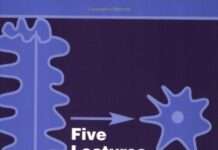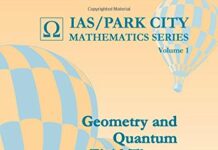
Ebook Info
- Published: 2011
- Number of pages: 215 pages
- Format: PDF
- File Size: 10.98 MB
- Authors: Daniel S. Freed
Description
From the reviews of the first edition: “This book exposes the beautiful confluence of deep techniques and ideas from mathematical physics and the topological study of the differentiable structure of compact four-dimensional manifolds, compact spaces locally modeled on the world in which we live and operate… The book is filled with insightful remarks, proofs, and contributions that have never before appeared in print. For anyone attempting to understand the work of Donaldson and the applications of gauge theories to four-dimensional topology, the book is a must.” #Science#1 “I would strongly advise the graduate student or working mathematician who wishes to learn the analytic aspects of this subject to begin with Freed and Uhlenbeck’s book.” #Bulletin of the American Mathematical Society#2
User’s Reviews
Reviews from Amazon users which were colected at the time this book was published on the website:
⭐Gauge theory as a field for study by mathematicians, and in particular, topologists, was initiated by Donaldson’s proof, which is the content of this book, that the only simply connected smooth closed 4-manifolds with definite intersection form are connected sums of complex projective planes (with the factors having either orientation). This was the first major advance in 4-manifold smooth topology beyond Rohlin’s theorem on the signature of a smooth spin 4-manifold and the Kirby-Siebenmann obstruction. Donaldson’s theorem was followed by many other related results, in particular, the discovery of the Donaldson polynomial invariants and various gluing and vanishing theorems, none of which appear in this early book, so this work is not suitable as a comprehensive reference for the theory. But it is still essential for a student wishing to learn gauge theory because of the extensive coverage of the requisite analysis, topology, and geometry that one needs to work in this field (or even read any later works). The authors endeavor to explain intuitively the motivation behind the different steps in this long proof (it takes more than 100 pages to prove the theorem), with some effective figures included as well.Donaldson’s proof is based on studying the moduli space of certain (anti-self-dual) solutions (mod gauge equivalences) of the Yang-Mills equations, the most fundamental equation in particle physics, which includes the vacuum Maxwell equations of electromagnetics, as well as those of QED and QCD, as special cases. For the SU(2) case over a smooth simply connected compact 4-manifold, the moduli space can be shown to be nonempty, orientable, smooth except for a finite number of points, near which the moduli space is a cone on a projective space, and having one noncompact end that is diffeomorphic to a collar on the original 4-manifold. This establishes a cobordism between the original manifold and a disjoint union of copies of CP^2, which proves the theorem. The various chapters of the book prove each of the aforementioned properties of the moduli spaces, mainly through tedious technical analytic results. Along the way the necessary material concerning bundles, connections, Sobolev spaces, Fredholm operators, index theory, classifying spaces, Bochner-Weitzenboeck formulas, etc., is presented, making this the most accessible gauge-theoretic work for (2nd-year) graduate students.The second author, Karen Uhlenbeck, was one of the pioneers in the field, deriving several critical analytic results about sequences of solutions to the YM equations that are ubiquitous in gauge theory proofs; the book includes her proof of the famed removable singularities theorem as an appendix. There’s also an early section on the construction of fake R^4s, one of the strangest results of 4-manifold topology (although I think Lawson’s
⭐does a better job of explaining this, and orientability as well). It is preferable to read the second edition, which includes a brief introduction that sumarizes advances in the field between 1984 and 1991, in addition to having been re-typeset.A demerit of the book is that it is filled with mathematical typos and many of the technical proofs require some modification in the choice of constants owing to some errors in the inequalities. However, the theorems themselves remain true, as the reader can verify with some effort.This book will provide the reader the tools to proceed to Donaldson and Kronheimer’s
⭐and Morgan’s
⭐and
⭐.
Keywords
Free Download Instantons and Four-Manifolds (Mathematical Sciences Research Institute Publications, 1) in PDF format
Instantons and Four-Manifolds (Mathematical Sciences Research Institute Publications, 1) PDF Free Download
Download Instantons and Four-Manifolds (Mathematical Sciences Research Institute Publications, 1) 2011 PDF Free
Instantons and Four-Manifolds (Mathematical Sciences Research Institute Publications, 1) 2011 PDF Free Download
Download Instantons and Four-Manifolds (Mathematical Sciences Research Institute Publications, 1) PDF
Free Download Ebook Instantons and Four-Manifolds (Mathematical Sciences Research Institute Publications, 1)

